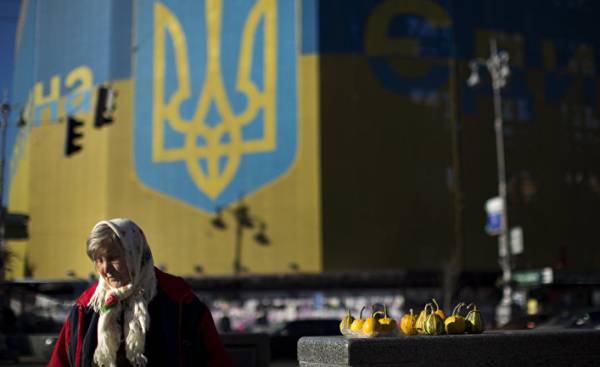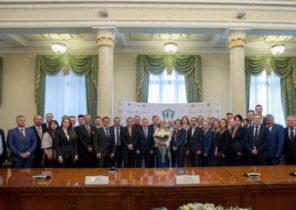
Three years ago Russia was the largest trading partner of Ukraine, but Kiev is almost completely reliant on Moscow on the issue of energy imports, and hoped that the Kremlin is the main buyer of the exports — agricultural products, steel and military equipment. But all this changed after the events of 2014. Since then, political and economic ties of Ukraine with Russia has deteriorated significantly, and they seem almost certainly continue to deteriorate, noted in his report, experts from the us private intelligence analysis company Stratfor.
Trade barriers
The conflict in Eastern Ukraine has been hit particularly hard by the economic relations with Russia. A large part of industrial production in Ukraine has been blocked due to full-scale war in the East. The state has lost a significant share of its exports, while gross domestic product has halved.
Around the same time, the Ukrainian authorities started to reduce imports of Russian natural gas and to argue about the level of prices, and then look for new partners in the energy sector. With this purpose in Kiev began to import natural gas in reverse from neighboring countries, such as Poland, Hungary and Slovakia. Although these supplies are still technically came from Russia, they were not subject to the same contractual terms as the direct imports from Russia. By the beginning of 2016 Ukraine has refused to import natural gas from its Eastern neighbor.
In 2013, before Euromaidan, Ukraine exported goods worth around 15 billion dollars annually. In 2014, this figure dropped to 9.8 billion in 2015 to 4.8 billion. And by 2016, Ukraine has exported to Russia only at $ 3.6 billion, which accounted for only 8% of the total exports. At the same time, exports to the EU in the same year amounted to 37%, according to Stratfor.
This trend intensified in 2017. In the beginning of the year, far-right activists and veterans of the ATO began an informal blockade of rail and truck transport — including deliveries of anthracite coal with the territory ORDO in Ukraine. Anthracite coal is about 15% of electricity production in Ukraine, and more than 37% of the annual consumption in the country accounts for coal of Donbass. Then the so-called leaders of the breakaway republics of DND and LNR responded to these actions: they seized control of Ukrainian factories and businesses in the uncontrolled territory of the Kiev authorities. In response, Kiev has established an official blockade of two republics, and almost all economic activity between Ukraine and these regions ceased.
Despite the fact that the reserves of anthracite coal in the country have fallen approximately 15% since the beginning of the blockade, the situation has reached a critical moment. Instead, the Ukrainian government withdrew from thermoelectric generation and increased the number of nuclear energy in its energy mix from 50 to 62%. In early April, Kiev has announced that it will begin to accumulate anthracite coal and will close for the summer generators, anthracite coal, to complete the upgrade. Ukraine has also begun to import coal from other neighboring countries, such as Poland, and studies of a similar trade deal with the United States and South Africa. However, such transactions can increase the cost of imports and, respectively, of the utility costs, the report says Stratfor.
However, if the blockade continues, it eventually will have its price. Experts have calculated that the blockade would lead to a loss of 1.3% of GDP this year, if I last until the end of December. To be precise, thus the projected GDP growth in the current year will be reduced by half. In addition, the international monetary Fund, which promised financial assistance to Ukraine at $ 17 billion, was detained last tranche of one billion dollars to assess the damage from the blockade, which will impact on the development prospects of the economy. The national Bank of Ukraine is optimistic about the prospects: he believes that the consequences of the blockade will be felt only a year, and most companies by 2018 will be able to find other sources of energy, and it will give a more reliable forecast of GDP growth to 3.2% next year.
In addition to the blockade, Ukraine also undertook and representative offices of major Russian banks operating on its territory. March 16, Kiev had imposed sanctions against them. It happened just a few weeks after Russian President Vladimir Putin has signed an order obliging the Russian authorities to recognize the identity documents of residents in the DNI/LC. March 27, Sberbank announced the sale of its subsidiaries to a consortium headed by the Latvian Bank Norvik and private Belarusian company, although the sale is still under control by the Antimonopoly authorities.
Breaking the links
Apparently, the Ukrainian and Russian economies will stay away from each other. Although it is unlikely that all economic activity between the Donbass and Ukraine will stop, but most legitimate rail and truck transportation will be terminated. As a result, DNR and LC will have no other choice but to ask for help to Russia, analysts Stratfor.
Freed from the historical dependence on Russia, Ukraine will focus on other markets, especially European, new export directions and the energy supply. Kiev will begin to diversify its diplomatic and partnerships abroad. In fact, Ukraine has already started to strengthen its economic and defense relationship with Poland and the Baltic States. And though Russia will always pose a real military threat to Ukraine, Kiev will be more opportunities to pursue a more aggressive foreign policy, as Russia’s role in the economy is declining.





